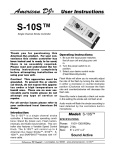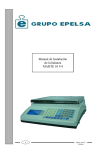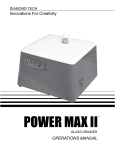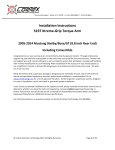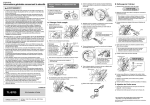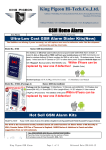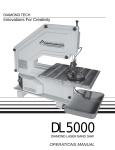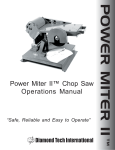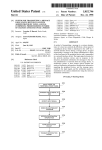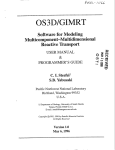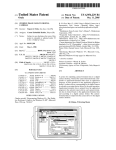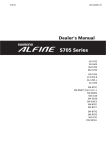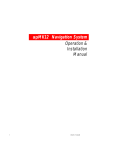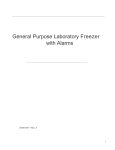Download The Wasser Instructional Guide in PDF format
Transcript
Wasser Glass is truly a remarkable and vibrant Artist Glass. It's rich opaque and semi-translucent colors allow the artist to use it in hot glass, as well as foil and lead applications. Thin and lightweight, it is easy to cut and shape with little or no shards. Wasser Glass has a 90 COE rating and low temperature-fusing capabilities, making Wasser an ideal glass for beginners and experts alike. WASSER COLOR, SIMPLICITY AND SUCCESS... INSTRUCTIONAL GUIDE D I A M O N D T E C H I N T E R N A T I O N A L Wasser fusing Color, Simplicity And Success Fusing With Wasser Glass - Glass Phases glass characteristic is extremely important when fusing Wasser A. HEATING PHASE Glass, due to it's unique thin qualities.) Layering the glass, fusing The time it takes to increase Wasser glass from room temperature slower, and not going to full fuse can reduce shrinkage. When to an ideal fusing temperature of between 1200° to 1340°F is full fusing several pieces of glass, place your base glass on a called the "Heating Phase." Because Wasser tacks and fuses at prepared kiln shelf or shelf paper. Using a tiny drop of adhesive, temperatures lower than other 90 COE glass, it is advisable to tack such as white glue, secure your glass pieces in place on top of and fuse at a slower rate. You should increase heat at a rate of the base glass and add layers, one at a time. 400°F per hour. This can be achieved by opening "peep" holes, Wasser to Wasser Full Fuse opening the kiln lid just a little and turning the kiln on low. These Slowly bring Wasser to 1280°F, periodically checking the glass. procedures will reduce the possibility of "shock" to the glass. Slowly raise the temperature to 1340° F. You may achieve the Wasser Glass is a very soft fusable glass; therefore, it may be desired result before you reach 1340° F; therefore, it is important necessary to turn the kiln on and off at the beginning of the to check and record changes in schedules as needed. Turn off Heating Phase to slow down the heating process. Keep in mind kiln and proceed to the Cooling Phase. when fusing additional layers of glass, an even slower heating Wasser to Bullseye, Uroburos and Spectrum Full Fuse phase is necessary to allow heat penetration through each layer When using Wasser between two layers of Bullseye, Uroburos or of glass. Spectrum 90 COE, start by bringing the kiln temperature to 1. TACK FUSING: Tack Fusing Wasser Glass gives a 1340°F (Wasser full fuse). At this stage turn the kiln to high and multidimensional and reflective appearance. To achieve a Tack fuse at the recommended temperature for the top and base Fuse place the glass on your kiln shelf and increase kiln glass. Maintain a "soak" at this temperature for 30 minutes temperature, as described in the heating phase, until it reaches depending on the size of your piece. Smaller pieces will "soak" 1150°F, then slow down the heating process. Wasser begins to for less time. Proceed to the Cooling Phase. soften at 1240°F . Please note: kilns are not all alike. There are some variances between kilns, especially the mini kilns. Pyrometers B. COOLING PHASE can be slightly off 10°-20°F and sometimes household currents will When the desired look has been achieved, turn the kiln off. To vary causing slight temperature differences. Remember to check stop the fusing process, flash vent the glass to let the heat out the piece frequently while fusing and record changes as needed. by holding the lid open for about 8-10 seconds or until the kiln Heating at a slower rate will give you more control over the end temperature drops to 1000°F. Replace the lid and turn kiln on result. low for 30 minutes. This will keep the kiln approximately 940°F, Once you have achieved the desired look, proceed to the allowing a minimal annealing cycle. Continue to cool at the Cooling Phase. following rates: 2. FULL FUSING: Wasser at full fuse will result in the glass 10°F/min. to 800°F combining to create a uniform thickness throughout. Please note, 15°F/min. to 700°F glass likes to be ¼ thick. When heating glass to full fuse, anything 20°F/min. to room temperature. less than 1/4" will shrink, anything with more will spread out. (This D I A M O N D T E C H I N T E R N A T I O N A L 5600-C Airport Blvd., Tampa, FL 33634 (813) 806-2923 (800) 937-9593 Fax: (813) 806-1988 www.dticrafts.com Wasser fusing Color, Simplicity & Success Bubble Control Wasser Glass Product Line Information Wasser has a smooth, thin surface which can trap air, resulting in bubbles in your glass. Decreasing the viscosity between the glass layers will reduce the amount of air bubbles. To decrease viscosity, Product # Style S125 Solid Color Dark Navy S197 Solid Gray S198 Solid Black follow Heating Phase instructions. This process will squeeze out air S199 Solid White bubbles trapped between the layers. S202 Solid Light Yellow S203 Solid Yellow S303-F Flash Orange-White Base can be achieved by cutting the base glass into sections, then S402-F Flash Red-White Base layering the glass design in such a way that the design covers the S501 Solid Brown S502 Solid Terra Cotta S601 Solid Light Mauve S603 Solid Mauve S701 Solid Mint S702 Solid Shamrock S703 Solid Light Green S801 Solid Light Blue S803 Solid Purple S804 Solid Royal Another way to minimize air bubbles is to reduce surface area. This cuts. (If you build your glass design on a piece of thin shelf paper, air will better be able to escape through the cuts.) Wasser Glossary and Definitions: Annealing: The process of slowly cooling glass between its softening point and its straining point. Each type of glass has its own unique annealing temperature and time. S805 Solid Turquoise C.O.E. (Coefficient Of Expansion): The measured expansion of P101 Pattern-Stripe Turq/Royal/Lt Gn/Blk heated glass based on the percentage of change in a glass rod P102 Pattern-Feather TerCot/Org/Nvy/Turq P103 Pattern-Spot Red/Org/Grey/Ylw heated one degree centigrade. This technical term is used by P104 Pattern-Feather Wht/Blk/Red/Grey glass manufacturers to rate their regularly tested glass. Fusers P105 Pattern-Spot Wht/Blk typically use glass that is 90 COE or 96 COE P106 Pattern-Spot Turq/Blk/White P107 Pattern-Stripe Ylw/Royal/Red/Org Compatibility: The absence of stress when two or more pieces of glass are fused together. Glasses that expand and contract at the same rate are said to be compatible and have the same COE. Firing Schedule: The program for heating and cooling glass. P108 Pattern-Spot Lt Mauve/Prpl/Mauve P109 Pattern-Spot Lt Mauve/Mauve/Lt Ylw/Mint P110 Pattern-Spots Lt Grn/Shmrk/Mint/Ylw P111 Pattern-Feather Turq/Lt Ylw/Org/Lt Prpl P112 Pattern-Spot Turq/Wht P113 Pattern-Stripe Gray/Lt Mauve/Lt Bl/Lt Prpl M101 Metallic Gold Fiber Paper: A paper composed of pressed ceramic fibers that M102 Metallic Silver can be used as an alternative to kiln wash. M103 Metallic Antique Copper Master Sample Set Soak Time: Holding glass at a predetermined temperature for a The best possible way to choose your colors is to have your own specific amount of time. sample set of Wasser colors. Full set includes 35 3" x 3" glass samples and technical information sheet. #S100A D I A M O N D T E C H I N T E R N A T I O N A L 5600-C Airport Blvd., Tampa, FL 33634 (813) 806-2923 (800) 937-9593 Fax: (813) 806-1988 www.dticrafts.com Wasser fusing guidelines Color, Simplicity & Success WASSER TO WASSER FUSING GUIDELINES For fusing pieces that are 2 glass layers Action Ramp Time Heating (from Room temp) 400°F/Hr Flash Venting N/A Annealing Soak N/A Cooling-Phase 1 10°F/min Cooling-Phase 2 15°F/min Cooling-Phase 3 (to room temp) 20°F/min Set Point 1340°F (726°C) 1050°F (565°C) 940°F (504°C) 800°F (426°C) 700°F (371°C) to room temp Soak Time 30 minutes (or desired effect) N/A 30 minutes N/A N/A N/A WASSER SLUMPING GUIDELINES For slumping a piece that is 2 glass layers thick Action Ramp Time Heating (from Room temp) 400°F/Hr Flash Venting N/A Annealing Soak N/A Cooling-Phase 1 10°F/min Cooling-Phase 2 15°F/min Cooling-Phase 3 (to room temp) 20°F/min Set Point 1180°F (637.8°C) 1050°F (565°C) 940°F (504°C) 800°F (426°C) 700°F (371°C) to room temp Soak Time 30 minutes (or desired effect) N/A 30 minutes N/A N/A N/A WASSER DRAPPING GUIDELINES For drapping a piece that is 2 glass layers thick Action Ramp Time Heating (from Room temp) 400°F/Hr Flash Venting N/A Annealing Soak N/A Cooling-Phase 1 10°F/min Cooling-Phase 2 15°F/min Cooling-Phase 3 (to room temp) 20°F/min Set Point 1180°F (637°C) 1050°F (565°C) 940°F (504°C) 800°F (426°C) 700°F (371°C) to room temp Soak Time 30 minutes (or desired effect) N/A 30 minutes N/A N/A N/A Make detailed notes on every project. Recording glass types, thickness and equipment used will help to repeat good results. Use the above guidelines as a reference only. Artist: Bernadette Mafood Artist: Darlene Johnson and Judy Lee Front Artwork Provided by Linda Duff Hughes D I A M O N D T E C H I N T E R N A T I O N A L BK101 / 9•02




